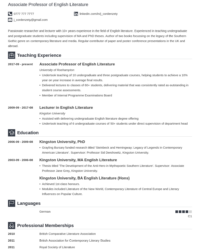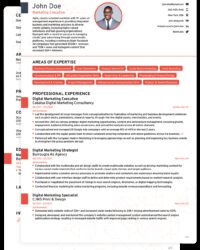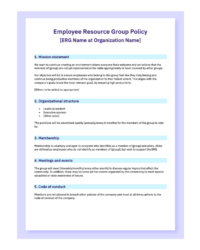Utilizing a pre-designed structure offers several advantages. It can save considerable time and effort, eliminate the need to start from scratch, and ensure a professional presentation. Access to diverse examples can also expose job seekers to best practices in CV writing, leading to improved clarity and impact. This can ultimately increase the likelihood of securing interviews.
This article will explore various types of CV structures, discuss key elements to include, and offer practical tips for customization and effective utilization in the job application process.
Key Components of a Curriculum Vitae Template
Effective curriculum vitae templates typically incorporate several key components to ensure a comprehensive and impactful presentation of a candidate’s qualifications. These components provide a framework for organizing information and highlighting relevant skills and experience.
1: Contact Information: This section includes essential contact details such as full name, phone number, email address, and professional social media profile links (e.g., LinkedIn). A professional-sounding email address is recommended.
2: Summary/Objective Statement: A concise overview of professional skills and career goals, tailored to the targeted job. This section provides a snapshot of key qualifications and aspirations.
3: Work Experience: This section details professional history, typically presented in reverse chronological order (most recent first). Each entry should include job title, company name, dates of employment, and a bulleted list of responsibilities and accomplishments using action verbs.
4: Education: Academic qualifications are listed, including degrees earned, institutions attended, graduation dates, and relevant coursework or specializations. High school information may be omitted for experienced professionals.
5: Skills: This section highlights technical and soft skills relevant to the target job. Skills can be categorized for clarity (e.g., technical skills, communication skills, leadership skills).
6: Awards and Recognition: Any achievements, honors, or awards received should be listed here to showcase accomplishments and contributions.
7: References: While not always included directly on the CV, a statement indicating that references are available upon request is customary. References should be contacted and informed beforehand.
These components provide a solid foundation for creating a compelling and informative CV. Adapting and tailoring these elements to specific job requirements is essential for maximizing impact and increasing the chances of securing an interview.
How to Create a Curriculum Vitae Template
Creating a robust curriculum vitae (CV) template requires careful planning and consideration of various factors, including content organization, formatting, and tailoring to specific job requirements. A well-structured template facilitates efficient customization and ensures a professional presentation.
1: Define the Target Audience: Identify the industries and roles the template aims to serve. This helps determine relevant sections and the overall tone.
2: Choose a Format: Select a chronological, functional, or combination format based on career progression and target roles. Chronological formats emphasize work history, while functional formats highlight skills.
3: Structure the Sections: Determine the key sections (contact information, summary/objective, work experience, education, skills, awards, references) and their order. Templates should offer flexibility for adding or removing sections as needed.
4: Select a Design: Opt for a clean, professional design that is easy to read and visually appealing. Consistent formatting, appropriate font choices, and clear headings contribute to readability.
5: Incorporate Placeholder Content: Include clear instructions and examples within each section to guide users. Provide suggestions for phrasing accomplishments and quantifying results.
6: Ensure Accessibility: Use a format compatible with various software and devices. Consider accessibility guidelines for users with disabilities.
7: Test and Refine: Thoroughly review and test the template to ensure functionality and ease of use. Gather feedback from potential users and make necessary adjustments.
By following these steps, one can develop a versatile and effective CV template suitable for a variety of job applications. A well-crafted template provides a solid foundation for presenting professional qualifications and experience in a compelling manner.
Pre-fabricated CV documents provide a valuable resource for job seekers, offering structure, guidance, and inspiration in crafting effective presentations of professional qualifications. Leveraging these resources can save time, ensure a professional appearance, and expose individuals to best practices in CV writing. Understanding the various components, formats, and customization options empowers job seekers to tailor their CVs effectively for specific roles and industries.
Careful consideration of the target audience, clear articulation of skills and accomplishments, and a polished presentation are crucial elements for success in the competitive job market. A well-crafted CV, built upon a strong template, can significantly enhance an individual’s prospects and open doors to new career opportunities. Continuous refinement and adaptation of these tools are essential for remaining competitive in the evolving professional landscape.


